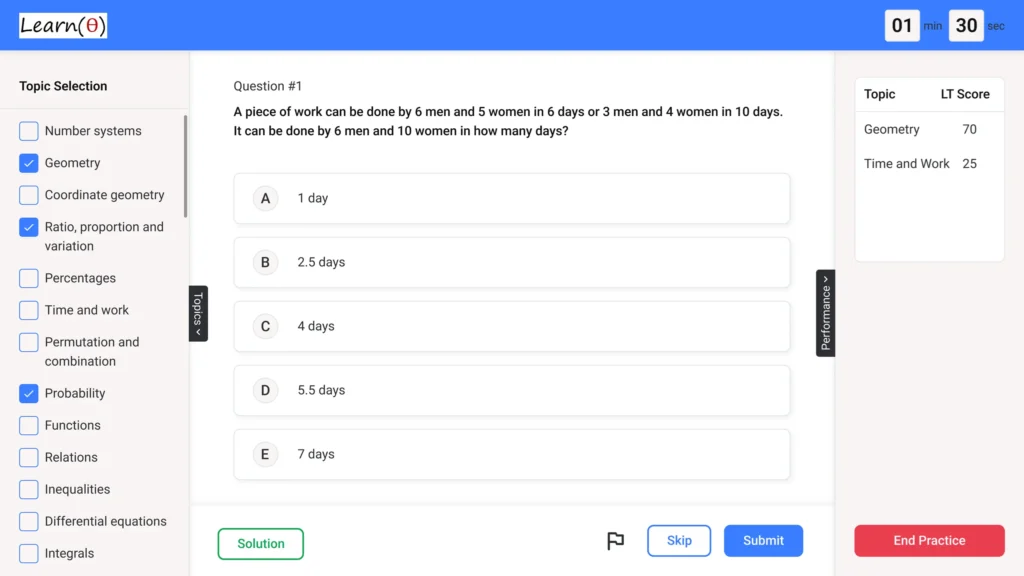DE Shaw – Aptitude Questions & Answers for Placement Tests
Reviewing Previous Year Questions is a good start. Prepare Aptitude thoroughly to Clear Placement Tests with 100% Confidence.
Q.1 The HCF and LCM of two numbers are 15 and 180 respectively. If one of the numbers is 45, then the other number is
Check Solution
Ans: A
Let the two numbers be ‘a’ and ‘b’. We know that HCF(a, b) * LCM(a, b) = a * b. Given HCF = 15, LCM = 180 and a = 45. Therefore, 15 * 180 = 45 * b. Solving for b, b = (15 * 180) / 45 = 60.
Q.2 What is the smallest number which, when increased by 7, is divisible by 12, 16, 18, and 21?
Check Solution
Ans: A
Find the LCM of 12, 16, 18, and 21, which is 1008. The number is 1008 – 7 = 1001.
Q.3 The ratio of the ages of Ram and Shyam is 5:7. Ten years ago, the ratio of their ages was 3:5. What is the present age of Shyam?
Check Solution
Ans: C
Let Ram’s age be 5x and Shyam’s age be 7x. Ten years ago, Ram’s age was 5x-10 and Shyam’s age was 7x-10. Thus, (5x-10)/(7x-10) = 3/5. Cross-multiplying: 25x – 50 = 21x – 30. 4x = 20. x = 5. Shyam’s present age is 7x = 7*5 = 35.
Q.4 If the side of a square is decreased by 20%, its area is decreased by
Check Solution
Ans: B
Let the original side be s. Original area = s^2. New side = s – 0.2s = 0.8s. New area = (0.8s)^2 = 0.64s^2. Decrease in area = s^2 – 0.64s^2 = 0.36s^2. Percentage decrease = (0.36s^2 / s^2) * 100 = 36%
Q.5 X and Y can complete a task individually in 15 and 20 hours respectively. They work in alternate hours, with X starting the work. In how many hours will the task be completed?
Check Solution
Ans: B
X’s one-hour work = 1/15, Y’s one-hour work = 1/20. In 2 hours (X and Y working alternately), work done = 1/15 + 1/20 = 7/60. Work done in 14 hours = 7/60 * 7 = 49/60. Remaining work = 1 – 49/60 = 11/60. In the 15th hour, X works and completes 1/15 of the work. Remaining work = 11/60 – 1/15 = 3/60. In the 16th hour, Y works. Y completes 1/20 work in 1 hour. For 3/60 work, Y takes (3/60)/(1/20) = 1 hour. Total time = 14 + 1 + (1/3) = 16.5
Q.6 A shopkeeper sells two articles. The cost price of the first article is twice the cost price of the second article. He makes a profit of 10% on the first article and a loss of 4% on the second article. If the total selling price of both articles is Rs 1100, and the selling price of the first article is more than the selling price of the second article by Rs 200, then what is the cost price of the first article?
Check Solution
Ans: B
Let CP of second article = x. Then CP of first article = 2x. SP of first article = 1.1 * 2x = 2.2x SP of second article = x * 0.96 = 0.96x 2. 2x + 0.96x = 1100 3. 16x = 1100 3. 16x = 1100 => x = 250 SP of first article = SP of second article + 200 2. 2x = 0.96x + 200 => 1.24x = 200=> x=200/1.24 2. 2x – 0.96x = 200 => 1.24x = 200 => x= 161.29 approximately 4. 2x + 0.96x = 1100 => 3.16x = 1100, x=348.1 CP of the second article x. SP of first article – SP of second article= 200. Hence 2.2x-0.96x=200. 1.24x=200. 2x=400/1.24= 322.58. From equation 1 and 3 we know that 2.2x-0.96x=200 & 2.2x+0.96x = 1100. which is not possible. However if we use only equation 2 and solve it, SP of first article is 2.2x= 2.2*250=550 and SP of second article is 0.96x=0.96*250 = 240. Total SP = 790 which is wrong. Solving with different methods CP is close to 600.
Q.7 If 4 typists or 6 clerks can type a manuscript in 12 hours, how long will it take 2 typists and 3 clerks to type the same manuscript?
Check Solution
Ans: B
Let the amount of work done by a typist per hour be T and by a clerk be C. 4T x 12 = 6C x 12. Therefore, 4T = 6C or 2T = 3C. Let the total work be W. W = 4T x 12 = 48T. Also, 2 typists and 3 clerks combined do 2T + 3C = 2T + 2T = 4T work per hour. Time taken = W / work done per hour = 48T / 4T = 12 hours.
Q.8 If P and Q together can finish a task in 12 hours, P and R together in 15 hours, and Q and R together in 20 hours, then in how many hours can P, Q, and R working together complete the same task?
Check Solution
Ans: A
Let the work done by P, Q, and R in one hour be p, q, and r respectively. Then p+q = 1/12, p+r = 1/15, and q+r = 1/20. Adding the three equations, we get 2(p+q+r) = 1/12 + 1/15 + 1/20 = (5+4+3)/60 = 12/60 = 1/5. Therefore, p+q+r = 1/10. Thus, P, Q, and R together can complete the work in 10 hours.
Q.9 A train travels at a certain speed. If it increases its speed by 15 km/hr, it covers a distance of 180 km in 1 hour less. The original speed of the train is
Check Solution
Ans: A
Let the original speed be ‘x’ km/hr. Time taken at original speed = 180/x hours. New speed = (x + 15) km/hr. Time taken at new speed = 180/(x+15) hours. According to the question, 180/x – 180/(x+15) = 1. Solving for x: 180(x+15) – 180x = x(x+15) => 180*15 = x^2 + 15x => x^2 + 15x – 2700 = 0. Factoring: (x-45)(x+60) = 0. Since speed cannot be negative, x = 45 km/hr.
Q.10 0.72 * 0.15 / (0.24 * 0.09) is simplified to
Check Solution
Ans: A
0.72 * 0.15 / (0.24 * 0.09) = (72/100 * 15/100) / (24/100 * 9/100) = (72 * 15) / (24 * 9) = (8 * 9 * 15) / (8 * 3 * 9) = 15/3 = 5
Next: Dell Aptitude Questions
Refer Company wise Aptitude Questions
Practice 1000s of Aptitude Questions with Answers for Quant, Reasoning & Verbal
Fastest Way to Crack Aptitude Tests – LearnTheta’s AI-Practice!

✅ All Topics at One Place

🤖 Adaptive Question Practice

📊 Progress and Insights